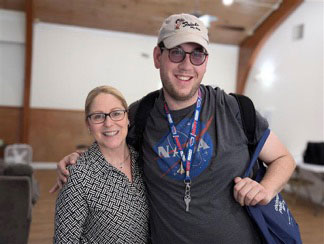Submitted by Jewish Cemeteries of Greater Cincinnati

Ahavas Achim Synagogue, 2020
Beneath a TQL Stadium parking lot are buried scattered bricks and stones of a very early Jewish congregation’s synagogue — all except one important piece, which has been preserved and honored through an unusual three way partnership.
In the early morning of May 13, 2020, under an overcast sky, six members of Football Club Cincinnati’s (FCC) demolition and construction team met with the leadership of Ohr Torah Cincinnati, an Orthodox Jewish school located in Deer Park. Their goal was the removal and preservation of a marble plaque embedded in the upper face of what was then Cincinnati’s second oldest standing synagogue building, built over 150 years earlier in 1866. As part of FCC’s project to transform the West End neighborhood of Cincinnati with TQL Stadium, FCC had purchased the former home of the Orthodox congregation Ahavas Achim, known in English as the Congregation of Brotherly Love, or by its nickname, Love Brothers.
Congregation Ahavas Achim, founded in March of 1848 when most of Cincinnati’s Jewish community lived downtown, first met near Race and 14th Streets, but the congregation experienced rapid growth in its early years. As a result, they built a magnificent synagogue building on the corner of John and Bauer (formerly known as Melanchton) Streets in Cincinnati’s West End. The new synagogue was the most resplendent building in the neighborhood and set a new standard for Jewish synagogues in Cincinnati.
On that day in 1866, when the congregation dedicated Ahavas Achim Synagogue, they installed a marble plaque on its exterior to proudly and permanently designate the building as a house of worship.

The plaque was made to reflect the design of the 10 Commandments and says: “Beis Haknesses K(ehilah) K(edosha) [Holy Congregation] – Ahavas Achim”
(Established in the year) [corresponding to the gematria of the Torah Verse] “I shall rest my presence among the Children of Israel.” Under the Hebrew, written in English is “Congregation of Brotherly Love/5626.”
Why this particular inscription? The secular year 1866 corresponded to the Hebrew year 5626. The Hebrew quote on the plaque is part of a verse from the second book of the Torah, Shemos/Exodus, chapter 29, verse 45, which says in full, “I shall rest my presence among the Children of Israel, and I shall be their G-d.” This verse was chosen for the Ahavas Achim plaque because it had the mystical Gematria value equal to the year of the building’s dedication.
Gematria is an ancient and mystical Jewish alphanumeric code which assigns a numerical value to a Hebrew name, word, or phrase. The builders of the synagogue clearly felt that this mystical connection added to the holiness of the building.
Then around 1905, as the center of Cincinnati’s Jewish community shifted away from the West End, Congregation Ahavas Achim sold its building to the German Evangelical Lutheran Emmaus Congregation. A couple years later, the Congregation of Brotherly Love established a new cemetery in what is now West Price Hill. Love Brothers Cemetery, now Conservative, is one of the 25 cemeteries cared for by Jewish Cemeteries of Greater Cincinnati.
Revelation Baptist Church occupied the old synagogue until 2020, when FCC bought it. Wishing to honor Cincinnati’s history as well as the history of Cincinnati’s Jewish community, FCC jumped at the suggestion by Ohr Torah school leaders to save the marble plaque from the Ahavas Achim structure. FCC professionally removed the plaque from the building and transported it to Ohr Torah’s school building in Deer Park.
There it was stored for three years until, knowing Jewish Cemeteries’ commitment to honor, preserve and sustain the Love Brothers Cemetery, Ohr Torah contacted JCGC and had the plaque transported to them. It has now been included in a history-centric installation being created at Loveland Cemetery, named Foundations of Our Future. This installation will honor and preserve Jewish community history by displaying marble and metal plaques from across the community. It will serve as an educational tool as well, showing the roles that many of our own families’ ancestors have played in shaping Cincinnati’s Jewish community, as well as in creating the greater fabric of Cincinnati.
Foundations of Our Future will be dedicated at a public event hosted by Jewish Cemeteries on September 10 in the afternoon. As that date approaches, future articles will tell the fascinating stories behind other plaques rescued from loss.
While there is always sadness when an institution from the past has to make room for the present and future, it is good that Judaism understands the importance of remembering the past — not just sweeping it away.




